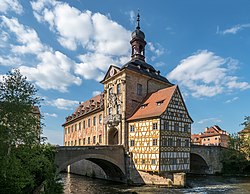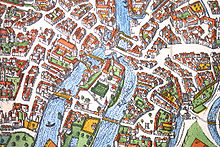Old Town Hall (Bamberg)
| Old Town Hall | |
|---|---|
 The Old Town Hall was in the Regnitz built |
|
| Data | |
| place | Bamberg |
| Construction year | First mentioned in 1387, redesigned from 1461 to 1467 |
| Coordinates | 49 ° 53 '30 " N , 10 ° 53' 13" E |
| particularities | |
| Part of the UNESCO World Heritage (old town), Bamberg's landmark | |
The old town hall in Bamberg is one of the most important buildings that characterize the historic city center . It is located between the mountain and island town in the left Regnitz arm. This location ...
"... marks the old rule border between the episcopal mountain town and the bourgeois island town and clearly shows the striving for power of the Bamberg bourgeoisie."
The landmark is built into the Regnitz River, with the Upper and Lower Bridge (originally a private bridge) leading away from it. Inside is the Ludwig porcelain collection belonging to the Bamberg city museums , one of the largest of its kind in Europe.
history
The town hall was mentioned for the first time in 1387 and was rebuilt between 1461 and 1467 so that it took on its present form. At this stage of construction it was mainly influenced by the Gothic.
Johann Jakob Michael Küchel redesigned the town hall in the years 1744 to 1756 in the Baroque and Rococo styles . Worth mentioning are the facade paintings , originally created by Johann Anwander in 1755 , which have been restored many times. After not much of these paintings could be seen in the 1950s, the painter Anton Greiner repainted it from 1959 to 1962. Both sides of the building are completely decorated with simulated allegorical scenes and architectural details, the typical illusion painting of this time. Small, actually figurative elements on the eastern side reinforce the spatial impression. The rococo balconies and coat of arms reliefs come from Jos. Bonaventure Mutschele.
The half-timbered house attached to the bridge tower, the Rottmeisterhäuschen, served as accommodation for the leaders of the guards.
reception
legend
The bishop of Bamberg did not want to give any of his land to the citizens for the construction of a town hall. As a result, the crafty citizens struck stakes in the Regnitz and thus created an artificial island on which they built their town hall. The Regnitz marks the old rule border between the episcopal mountain and the bourgeois island town.
painting
The old town hall was the subject of several paintings by the impressionist August von Brandis .
Monument protection
The building is a monument . The description reads:
"Upper Bridge 1. City Hall, assembly on a Regnitz Island, connected to the banks by two bridges (cf. Upper Bridge and Lower Bridge): two-storey town hall building above a high stone basement, in the core 1461-67, rebuilt 1619, redesigned 1744-56, facade painting , originally reconstructed by Johann Anwander in 1755, 1960 ff., bridge tower rebuilt around 1385, rebuilt in the 15th century and probably increased by one floor with a lantern hood by Martin Mayer from 1749-51, balconies richly decorated with rocaille ornamentation and coat of arms by Joseph in 1755/56 Bonaventura Mutschele (replaced in 1883/94 by copies by Philipp Dorsch and Lorenz Kamm), in front of that Rottmeister's house sitting on the icebreaker of the Upper Bridge, three-storey half-timbered building with a gable roof, re-qualified in 1668. "
Similar buildings
Similar to the bridge town hall in Bamberg, the town hall built over a former town gate between the towns in Warburg (Westphalia) and the town hall built over a stream in Mühlhausen (Thuringia) represent political compromises between two regional authorities. In Bamberg, there was a difference between secular and spiritual Urban area mediated, in Mühlhausen between different market areas and in Warburg between the two formerly independent cities of Warburg-Altstadt and Warburg-Neustadt, which only merged into one city in 1436.
See also
literature
- Ph. M. Halm: The town hall in Bamberg and its fresco decorations. In: The preservation of monuments. Volume 5, No. 3, February 25, 1903, pp. 19-21.
Web links
- Official website
- "The Bamberg Town Hall" (legend)
- Foracheim.de : Old Town Hall Bamberg
Individual evidence
- ↑ Page no longer available , search in web archives: stadt.bamberg.de
- ↑ Information board on the east side of the old town hall of Bamberg
- ↑ bamberg-guide.de: Altes Rathaus , accessed on May 31, 2013.
- ↑ Monument List Bavaria, file number D-4-61-000-986 ( Monument List Bavaria: Bamberg , p. 117; PDF)



